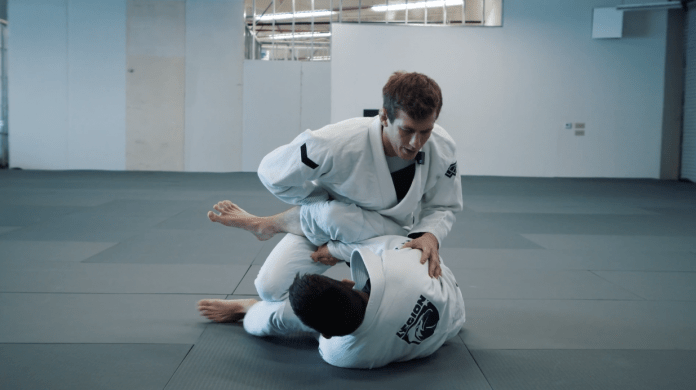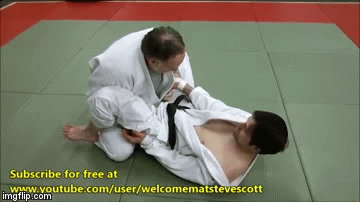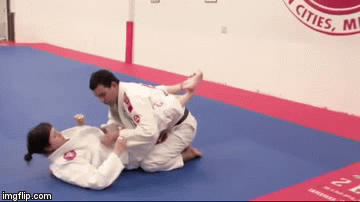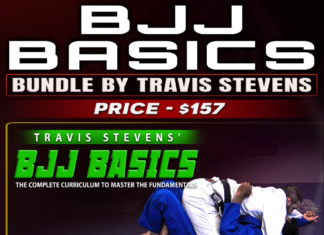
Can’t pass guard? There’s a good reason for that – you can’t. Like you really can’t actually physically pass anyone’s guard in Brazilian JIu-JItsu. The perfect example is the closed guard. Pass it without opening. Can’t, right? Then why would you presume that you could pass all other guards directly? The one single thing that makes guard passing really difficult is trying to pass an actual guard. You’ll get a successful pass by getting past the legs. Guards are designed to keep you from doing that. Hence you can’t just pass a guard. You can pass the legs, though, with a 100% success rate. And achieving that requires a bit of sneakiness ion your part. At least if you want to be successful with your BJJ pass rate.
Passing is extremely hard, and just as fun, if not more. However, being smart about it is going to make your life a lot easier. If you want to mask leg lock attacks with passes, then by all means, keep doing what you’re doing. But, if you want to actually get past someone’s legs and into a better top position, you’ll need to finish a BJJ pass or two. Why not turn the tables to your advantage completely? The Arm Trap BJJ pass is one option you have at your disposal. AS long as you’re aware of the stages of passing, you can gain a real advantage by introducing this concept into your game.
The Concept Behind The Arm Trap BJJ Pass
The stages of passing guard are something I’ve talked about before. The concept is that guard is impossible to pass because they’re designed to keep you at distance and offer attacks to the bottom person. However, you can most certainly get past them. The thing is, you need to make sure there’s no guard stopping your form passing the legs. To achieve that, you need to make sure the guard you’re up against is not a threat. That can be done with minimal movement and some grip and weight distribution adjustments, depending on the guard. Step two is breaking the structure of the guard, thus arriving in a position where you can easily go past the legs. Breaking the guard’s structure is opening it, in the case of the closed guard, or removing a hook or two, in the case of most open guards.
However, passing is still not that easy. Regardless if you’re after points or simply a better position to submit from, you’ll have to settle in a good spot after you pass the legs. That is not an easy task to accomplish. One thing people forget to factor in when passing is guard recovery. That is the ability of the bottom person to recover a guard position after you get past their legs, but before you settle in side control, for example. In other words, there are layers to passing the legs, and you need to anticipate them in order to execute any BJJ pass.
So, the concept behind the arm trap is to make sure you peel an entire layer of defense before it even comes up. Somewhere between the stages of making the guard ineffective and passing the legs, you need to look to tie up one of the opponent’s arms. There are many ways to do this, but if you can get it behind their back, you’ll really leave them defenseless once your BJJ pass takes you past the legs.
Passing The Closed Guard
The closed guard used to be a nightmare for me to pass. I just couldn’t get out of it and it lasted well into my blue belt days. No wonder I went so deep into trying to figure out how passing works. Well, if you want to do a BJJ pass by using the Arm Trap method, you actually have several options.


The same arm position as in the lapel arm trap also works perfectly with the Tozi pass.
Passing Half Guard
You can use the same concept of arm trapping to pass the half guard as well. The only thing you’d do differently is the method of trapping the arm, which depends a lot on the half guard variation you are in.


Conclusion
A BJJ pass concept that takes care of guard recovery even before the opponent realizes they need it, is a BJJ pass worth knowing. The concept looks easy but does require a lot of repetition in order to get the timing right. Once you do, though, you’ll have an easy time passing any guard you come up against


![Darce Choke Encyclopedia – Origins, Mechanics and Variations [2025] BJJ, choke, Brabo, BJJ Darce Choke, D'arce Choke, Darce BJJ Choke](https://bjj-world.com/wp-content/uploads/2017/11/JungPoirierLeeYahoo-218x150.jpg)









![Leg Locks Finishes Helena Crevar DVD Review [2025] Leg Locks Finishes Helena Crevar DVD Review](https://bjj-world.com/wp-content/uploads/2025/04/leg-locks-finishes-helena-crevar-dvd-review-218x150.png)


![Leg Entanglement System: X Lock Owen Jones DVD Review [2025] Leg Entanglement System: X Lock Owen Jones DVD Review](https://bjj-world.com/wp-content/uploads/2025/04/leg-entanglement-system-x-lock-owen-jones-dvd-review-218x150.png)
![[WATCH] John Wick Invitational 2 Delivers Viral Suit-Jitsu Spectacle [WATCH] John Wick Invitational 2 Delivers Viral Suit-Jitsu Spectacle](https://bjj-world.com/wp-content/uploads/2025/04/john-wick-invitational-2-suit-jitsu-spectacle-218x150.png)
![Defensive Wrestling for Jiu-Jitsu Pat Downey DVD Review [2025] Defensive Wrestling for Jiu-Jitsu Pat Downey DVD Review](https://bjj-world.com/wp-content/uploads/2025/04/defensive-wrestling-for-jiu-jitsu-pat-downey-dvd-review-218x150.png)

![How to Double Leg Anyone Kevin Lee DVD Review [2024] How to Double Leg Anyone Kevin Lee DVD Review](https://bjj-world.com/wp-content/uploads/2024/11/how-to-double-leg-anyone-kevin-lee-dvd-review-100x70.png)


![Modern Split Squat Passing Jason Rau DVD Review [2024] Modern Split Squat Passing Jason Rau DVD Review](https://bjj-world.com/wp-content/uploads/2024/11/modern-split-squat-passing-jason-rau-dvd-review-100x70.png)

![Woj Lock the World Chris Wojcik Ankle Locks DVD Review [2024] Woj Lock the World Chris Wojcik Ankle Locks DVD Review](https://bjj-world.com/wp-content/uploads/2024/12/woj-lock-the-world-chris-wojcik-dvd-review-100x70.png)

![Feet Finder Foot Sweeps Christian Ozbek DVD Review [2024] Feet Finder Foot Sweeps Christian Ozbek DVD Review](https://bjj-world.com/wp-content/uploads/2024/09/feet-finder-foot-sweeps-christian-ozbek-dvd-review-100x70.png)


![Slip N Slide Into Victory Julián Espinosa DVD Review [2025] Slip N Slide Into Victory Julián Espinosa DVD Review](https://bjj-world.com/wp-content/uploads/2025/01/slip-n-slide-into-victory-julian-espinosa-dvd-review-100x70.png)


![Gracie Secrets Closed Guard Kyra Gracie DVD Review [2024] Gracie Secrets Closed Guard Kyra Gracie DVD Review](https://bjj-world.com/wp-content/uploads/2024/12/closed-guard-kyra-gracie-dvd-review-100x70.png)
![10th Planet Leg Locks Jeremiah Vance DVD Review [2025] 10th Planet Leg Locks Jeremiah Vance DVD Review](https://bjj-world.com/wp-content/uploads/2025/01/10th-planet-leg-locks-jeremiah-vance-dvd-review-100x70.png)

![Leg Lock Entries Helena Crevar DVD Review [2025] Leg Lock Entries Helena Crevar DVD Review](https://bjj-world.com/wp-content/uploads/2025/03/leg-lock-entries-helena-crevar-dvd-review-100x70.png)
![Spider and Lasso Guard Jared Welman DVD Review [2025] Spider and Lasso Guard Jared Welman DVD Review](https://bjj-world.com/wp-content/uploads/2025/01/spider-and-lasso-guard-jared-welman-dvd-review-100x70.png)
![Countering with Crab Ride Anthony Budion DVD Review [2025] Countering with Crab Ride Anthony Budion DVD Review](https://bjj-world.com/wp-content/uploads/2025/03/countering-with-crab-ride-anthony-budion-dvd-review-100x70.png)
![Eoghan O’Flanagan Bundle Down Right Sloppy Jiu-Jitsu Review [2024] Eoghan O'Flanagan Bundle Down Right Sloppy Jiu-Jitsu Review 2024](https://bjj-world.com/wp-content/uploads/2024/09/down-right-sloppy-jiu-jitsu-eoghan-oflanagan-bundle-100x70.png)

![Best Marcelo Garcia Techniques by Team Marcelo Garcia DVD Review [2025] Best Marcelo Garcia Techniques by Team Marcelo Garcia DVD Review](https://bjj-world.com/wp-content/uploads/2025/02/best-marcelo-garcia-techniques-dvd-review-100x70.png)
![X-Guard Trickery Kyle Sleeman DVD Review [2025] X-Guard Trickery Kyle Sleeman DVD Review](https://bjj-world.com/wp-content/uploads/2025/03/x-guard-trickery-kyle-sleeman-dvd-review-100x70.png)

![Leg Locks Finishes Helena Crevar DVD Review [2025] Leg Locks Finishes Helena Crevar DVD Review](https://bjj-world.com/wp-content/uploads/2025/04/leg-locks-finishes-helena-crevar-dvd-review-100x70.png)
